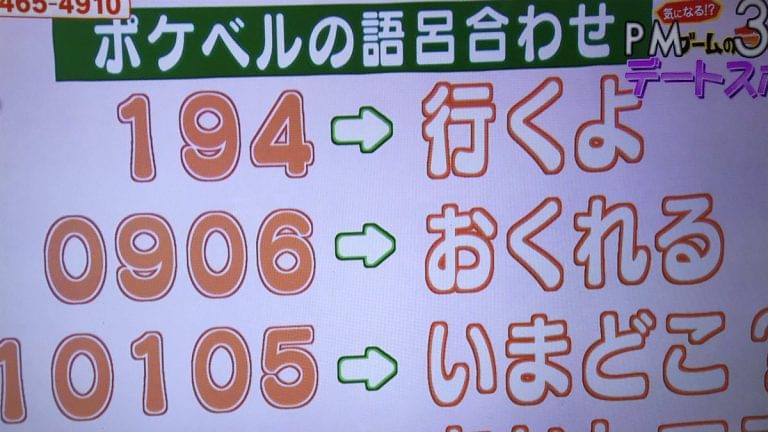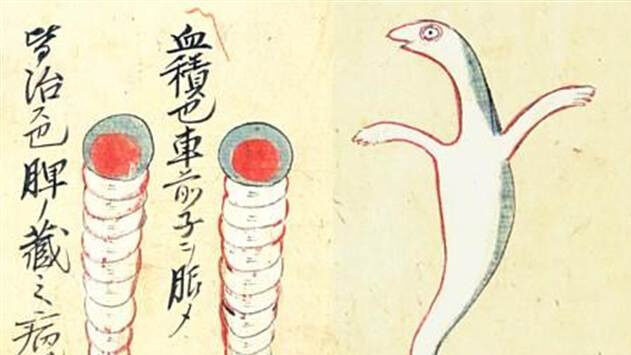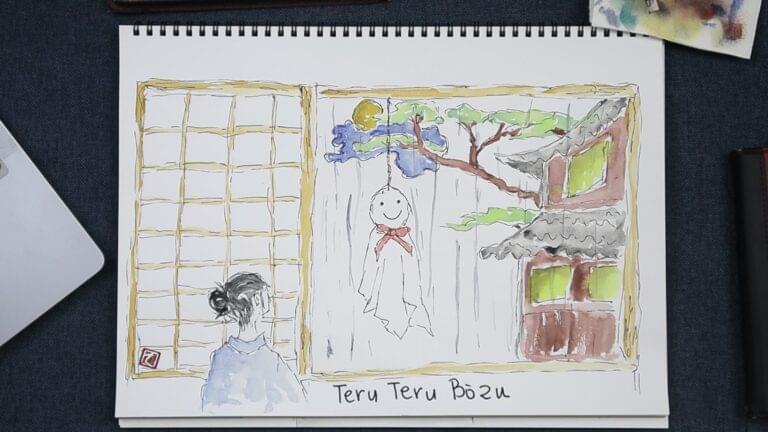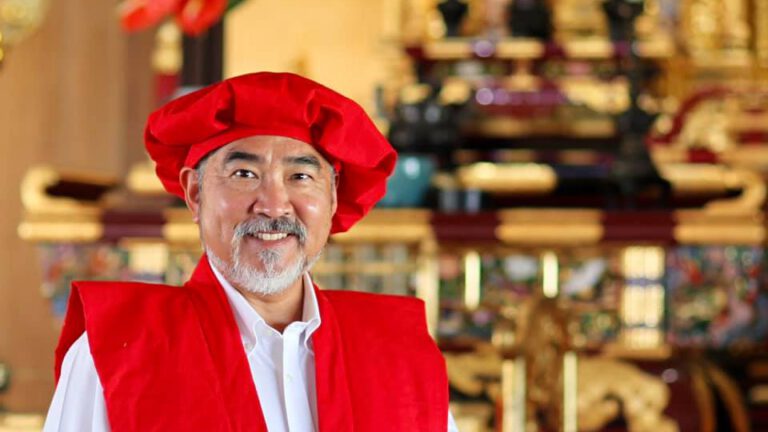In Japan “Kagome Kgome” is an old children’s game and the song that goes along with it. It’s interesting because the mysterious lyrics have several different interpretations and most of them are pretty grim.
So listen to episode 53 of Uncanny Japan where I talk about this creepy song and several of the theories behind those odd lyrics.
An Introduction to Kagome Kagome
Let’s play a game.
You’re in a field on a warm, breezy spring day with a dozen or so children. Everyone gathers around, and then a boy calls out:
“Saisho wa gu!”
All of you stretch out your arms and in unison make a fist when he says the word “gu”.
Then without breaking rhythm the boy calls out: “Jan ken pon!”
Next, perfectly timed, at the word “pon” everyone makes one of three hand shapes: a fist for rock, called gu; two fingers for scissors called choki; or an open palm for paper, pa.
After a quick glance and noticing it’s a draw with mix of rock, paper, scissors all being shown, he quickly sings out: “Aiko desho.”
Another draw, “Sho sho sho!” “Sho sho sho!”
Over and over until finally you’re standing there, your arm outstretched, your hand flat showing “pa” or paper, while all the other children are sporting scissors, choki.
You lose.
Everyone laughs. You’re It. In Japanese games if you’re “it”, you’re called the “oni” or ogre or demon.
A little girl pulls a long piece of cloth from her pocket and makes you sit on the ground. She starts to tie the blindfold around your head. Before everything goes black, though, you see all the other children join hands and make a circle around you.
The cloth is tied tightly. You are effectively blinded. The children begin to sing.
“Kagome kagome”
Hey hey, everyone. How are you all doing this pre-rainy season. I’m doing okay, thank you. I hope you are all healthy and happy.
One cool benefit to living in this old house is that my backyard is literally a series of rice fields. Last week I watched the farmer till them, flood them, and then plant them. I don’t know how frogs work exactly, like why don’t they get ground up into mulch when farmers till? But there is one thing I do know, the day after the water hit that dirt, they came out en masse. Listen to them all jolly-like.
A heads up to my five dollars and up Patrons, you’ll be getting a 30 or 40-minute binaurally miked frog symphony to chill out to soon. Longer if you’d like. These guys are at in all night long.
Now before I get into today’s topic, I’m really excited to share something wonderful and free with all of you. We’ve made an animation for an obscure Japanese folktale I translated and retold.
We being John Cairns, writer, director, editor, and animator. He did the movie Schoolgirl Apocalypse. Absolutely check him out, and watch the trailer for that movie on Youtube if you get a chance. So John did the animation for the story. Second was Rich Pav, who you’ll remember does all things sound and tech-related for Uncanny Japan. He did the sound effects. And finally me. All I did was find the story, retell, and narrate it.
The story is called “The Hell Carrot”. It’s on the Uncanny Japan Youtube channel. But you can find it by simply Googling The Hell Carrot. If you listen this podcast and have an inkling of interest in Japan and quirky stories, I really think you’ll enjoy it. I am so proud of what John and Richard did. So if you’d be so kind, while you’re there, you can give the video a thumbs up and even let us know what you think.
Okay, on to today’s topic. After last week’s “putting a curse on someone” episode, I thought I’d do something light. But, um, that didn’t happen. Sorry.
You see, there’s this other topic I’ve been dying to talk about and, again, since I have more time now, I was able to read up on it some more. And the more I read the more I wanted to share it with you.
Have you ever heard of the Japanese children’s song called “Kagome Kagome”? The game itself is a little like blind man’s bluff. One child is chosen to be an oni, blindfolded and made to sit on the ground while all the other children hold hands and walk around the oni singing the Kagome Kagome song.
How to Play Kagome Kagome
The last line of the song is basically, Who is behind you? So when the song stops, the seated child guesses which one of their friends is directly behind them. Not scary at all.
What’s chilling are the lyrics. Not outright scary in and of themselves, mind you, but nuanced in such a way that there are dozens upon dozens of theories about what they actually mean. And most of these meanings are quite dark.
I guess it’s like those old western nursery nursery rhymes that have sinister meanings, like London Bridge and Ring Around the Rosies. But we all know about them.
I thought Kagome Kagome might be new to you, so here we go.
Meaning of the Lyrics
First, here is the most common version of the lyrics:
Kagome kagome / kago no naka no tori wa
Itsu itsu deyaru / yoake no ban ni
Tsuru to kame ga subetta
Ushiro no shoumen daaare?
Very generally that would be:
kagome, kagome, a bird in a cage,
When oh when will it come out?
In the night of the dawn, the crane and turtle slipped
Who is behind you now?
That’s more or less a literal translation and probably what little children think when they sing it. However, there are a lot of people through the years, scholars included, who have different interpretations of the song.
So let me talk about a few. But first the words kagome, kagome. It isn’t even agreed upon what those two repeated words mean. Kagome could mean:
1. The holes in the basket that is referred to
2. The shape of those holes, which would be a hexagon
3. A pregnant woman
4. A caged bird
5. A corruption of the word kakome, which means to surround or circle
Or finally number 6, it could mean to be lost
Now let me take each line of the chant and shed a little more light into what they mean before getting into the various dark speculations.
Kago no naka no tori wa:
The word kago can mean cage or basket, so a bird inside a cage or basket is the obvious meaning.
However, some believe the word tori isn’t bird but a torii, or a shrine gate. And that kago means a bamboo fence. A torii surrounded by a bamboo fence, would mean a shrine.
Then you have the people who translate kagome as a pregnant woman. In that case the bird inside a cage would refer to the woman’s unborn baby.
Next line: Itsu itsu deyaru
Deyaru could be translated as deau. When oh when will we meet? Or When oh when will it come out?
Next: Yoake no ban ni:
This line threw me. Yoake means the end of night, so dawn. But ban means night. So it’s a contradiction, in the night of the dawn. Some think it just means nighttime, some say it means from morning until night, some believe it means an inability to see light, and some hold that it refers to a time of day that is neither night nor day, a twilight time.
Okay, next: Tsuru to kame ga subetta:
Tsuru means crane and kame, turtle; both symbols of long life and good fortune. Suberu means to slip. Subbetta is past tense. They slipped. The idea of two lucky symbols slipping could mean misfortune or a life that has been shortened, or even death.
The last line: Ushiro no shoumen daare?
Literally, who stands behind? I read that it could also be ushiro no shonen daare? Who is the boy behind. But either way the line is asking who is behind. Sounds innocent enough.
Well, let’s get into a couple of the theories and they’re all grim.
Interpretation 1: The Forlorn Prostitute
The first one is that the song is about a woman who was forced to be a prostitute. Kago no naka no tori wa: She’s the bird in a cage. Itsu itsu deyaru: When oh when will I be able to escape this life. And very sadly, the last line meaning who stands behind is her asking who is next in line?
Interpretation 2: The Murdered Pregnant Woman
A second notion states that it’s a song about a pregnant woman. Remember that some interpret kagome as meaning a pregnant woman? Well, the tori in a cage is referencing her unborn child and she’s asking when oh when will it be born? The twist, at some strange hour she is murdered, one version saying she was pushed down some stairs: tsuru to kame ga subetta. The last line is her ghost asking ushiro no shoumen wa daare, who is standing behind me, who is it that murdered me?
Interpretation 3: The Executed Convict
Okay, idea number three. That it’s a tune about a convict about to be executed by having his head cut off.
The bird in the cage is the convict. The crane and turtle slipping are both his bad luck and the fact his life is going to be shortened very soon. The last line is really interesting because there are variations on its meaning.
One, simply who is behind me or who is the executioner going to be? A second more exciting theory, the prisoner get executed, his head is now on the ground in such a way that he sees his own body but doesn’t recognize it. Who is that behind me?
Interpretation 4: The Monstrous Child
Okay, one more dreadful idea is that this sweet children’s song is a song being sung by a monster child. He’s locked up, kago no naka no tori, and wondering when he will be released. But the truth of the matter is, the child has killed his entire family.
No real details, but there is also the idea that by joining in on the chant, the children circling are invoking some kind of god to descend into the child sitting in the middle. What for? I don’t know.
And lastly the only positive interpretation I could find was that it was a a chant giving hints to where a treasure is buried. But no thoughts as to what those hints aer or where exactly that treasure might be. I mean those are some pretty vague hints.
Something I find intriguing about kagome kagome is that while the children’s songs I grew up with might also have a more sinister underlying meanings, it’s generally agreed upon that there is a single hidden meaning per song. For example: Ring around the rosie a pocket full of posies ashes ashes we all fall down is about the black plague.
Kagome Kagome has so many different interpretations and no one can agree on any one of them. Which is kind of mysterious in and of itself.
So which story do you like best? The prostitute, the pregnant woman, the prisoner, or the monster child? Maybe you like invoking gods or searching for impossible to find treasures. Or have you heard of a different theory of the meaning to the old children’s song Kagome kagome? If you have please let us know. Or have you made up one yourself? The lyrics are definitely up for interpretation.
So that’s all for today’s show. Remember to search for The Hell Carrot and watch the animation John Cairns, Rich Pav and I made. It’s a hoot.
And if you’d like to support the show, you can on Patreon for as little as two dollars a month, although for $5 you can get access to over thirty retold Japanese folktales, binaurally miked soundscapes, recipes and more. My patrons are made of awesome and sweetness and I think you’d fit right in.
Thank you all for listening, stay healthy and safe, and I’ll talk to you again in two weeks.
Credits
Intro and outro music and that final creepy Kagome Kagome piano and rain bit by Julyan Ray Matsuura







I actually read a theory that this song is about where Arc of Covenant is hidden (Kagome mark being the Star of David.) in connection to conspiracy theory about how one of lost tribes landed in Japan. There are some similarities in Japanese and Jewish monarch tradition and mythologies from what I understand.
Also, the lady lyric “Ushiro no shomen” is as contradictory as “Yoake no ban” because it literally means “Who is in the front of your back.” So the story I heard was this was about the ghost or spirits behind you
I think I did come across this, but only found a tiny bit. This is all so fascinating. It makes me want to start digging around again. Thank you for letting me know. (^_^)d
I actually get to know about it after listening its lines from Furuta Nimura (Tokyo Ghoul:Re). I had been searching for it and finally I found it. And I think it was worth it. This song is actually quite dark.
So glad I was able to help you solve the mystery of the song. Yes, it is quite dark, isn’t it?
Wow. Freaky freaky. Thx for sharing.
I know there are possession stories in japan but do they have any weird possession rituals like western stuff talks about?
Do you mean like exorcisms? Oharai or Yakubarai are quite common and are a way of removing evil or some bad spirit. Going to a Shinto shrine to be cleansed isn’t uncommon either.
Thank you for the lyrics/explanations! Surprised I had not looked into this before, or at least not familiar with several interpretations.
I first heard of “Kagome, Kagome” from a now-old PC game, Touhou 8: Imperishable Night; the 4th stage theme “Cinderella Cage ~ Kagome Kagome”.
KA, I’m not a gamer myself, but I love hearing how people are finding and being introduced to all this old culture through games and manga/anime. Thank you for sharing. ╰(*´︶`*)╯♡
i saw that on a anime character edit, i guess, i like these scary things.. btw, i like first theory, I almost cried.
Thank you for this! I heard about it from the anime InuYasha, where the main female character is called Kagome, and this song actually plays a role in her arc. Pretty cool to read an analysis of it, I love that stuff!
You’re welcome. I remember Inu Yasha from back when my son used to watch it. I had forgotten about the character Kagome!